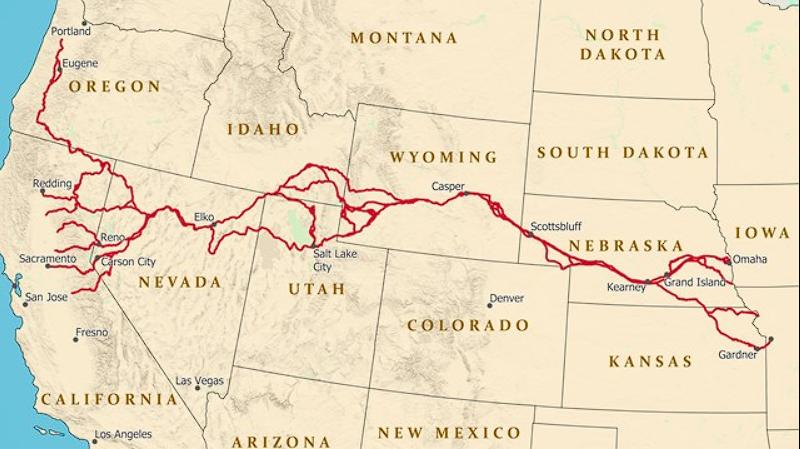The California Trail, a historic route that traversed the rugged terrain of Nevada, played a pivotal role in the westward expansion of the United States. This trail, first blazed by the Bartleson-Bidwell Party in 1841, witnessed the passage of hundreds of thousands of pioneers seeking new opportunities in the West.
The Epic Journey Along the California Trail
The California Trail was a lifeline for westward migrants, but it was also a perilous journey fraught with challenges and hardships.
The First Pioneers: Bartleson-Bidwell Party
The Bartleson-Bidwell Party’s pioneering journey in 1841 marked the beginning of the California Trail’s use as a major migration route.
- Blazing the Trail:
- The Bartleson-Bidwell Party was the first wagon train to successfully navigate the California Trail through Nevada.
- Their journey established a route that would be followed by countless others.
- Overcoming Obstacles:
- The party faced numerous challenges, including harsh terrain, lack of water, and encounters with Indigenous peoples.
- Their perseverance and determination paved the way for future migrations.
- Historical Significance:
- The Bartleson-Bidwell Party’s journey is a significant milestone in the history of westward expansion.
- Their experience provided valuable knowledge and insights for those who followed.
Mass Migration: The 1860s and Beyond
The 1860s saw a surge in migration along the California Trail, with hundreds of thousands of people making the arduous journey in covered wagons.

- Westward Expansion:
- The California Trail played a crucial role in the westward expansion of the United States.
- It facilitated the movement of people and goods to the newly acquired territories.
- Population Growth:
- By 1869, an estimated 450,000 people had traveled the California Trail through Nevada.
- This mass migration led to significant population growth in the western territories.
- Economic Impact:
- The California Trail stimulated economic development in the West, creating opportunities for trade and settlement.
- It contributed to the growth of towns and industries along the route.
The 40-Mile Desert: A Test of Endurance
The 40-mile stretch of desert between Lovelock and Fernley was the most challenging section of the California Trail, testing the limits of human endurance.
- Waterless Wilderness:
- The lack of water made this section of the trail particularly difficult and dangerous.
- Travelers faced dehydration, heatstroke, and other health risks.
- Abandoned Wagons:
- The harsh conditions led to the abandonment of wagons and supplies, leaving behind a trail of wreckage.
- Even in the 1930s, remnants of these abandoned wagons could still be found near Fallon.
- Human Cost:
- The 40-mile desert took a heavy toll on travelers, with many succumbing to the harsh conditions.
- The journey was a testament to the resilience and determination of the pioneers.
Legacy and Impact of the California Trail
The California Trail left an enduring legacy, shaping the landscape and history of Nevada and the American West.
Transformation of the Landscape
The California Trail’s impact on the landscape was profound, leaving behind visible traces of human activity.

- Wagon Tracks and Ruts:
- The passage of countless wagons left behind deep tracks and ruts, scarring the landscape.
- These physical remnants serve as a reminder of the trail’s historical significance.
- Settlements and Towns:
- The trail led to the establishment of settlements and towns along its route, transforming the region’s demographics.
- These settlements provided essential services and supplies to travelers.
- Environmental Impact:
- The increased traffic along the trail led to environmental changes, including soil erosion and depletion of natural resources.
- The trail’s impact on the environment is still visible today.
Cultural Exchange and Conflict
The California Trail facilitated cultural exchange between different groups, but it also led to conflict and displacement.
- Indigenous Encounters:
- Travelers along the trail encountered Indigenous peoples, leading to both trade and conflict.
- These encounters had a profound impact on Indigenous cultures and territories.
- Cultural Diffusion:
- The trail facilitated the spread of ideas, technologies, and cultural practices between different regions.
- This cultural diffusion contributed to the development of a unique Western identity.
- Displacement and Loss:
- The influx of settlers led to the displacement and loss of Indigenous lands and resources.
- The trail’s legacy includes both cultural exchange and the tragic consequences of displacement.
Enduring Symbol of the American West
The California Trail remains an enduring symbol of the American West, representing the spirit of adventure, resilience, and the pursuit of opportunity.
- Myth of the West:
- The trail has become a central part of the myth of the American West, embodying the ideals of rugged individualism and self-reliance.
- It represents the frontier spirit and the drive to explore new horizons.
- Historical Memory:
- The trail is preserved in historical memory through museums, monuments, and educational programs.
- It serves as a reminder of the challenges and triumphs of westward expansion.
- Inspiration for Future Generations:
- The California Trail continues to inspire future generations with its stories of courage, perseverance, and the pursuit of the American dream.
- It remains a symbol of the enduring spirit of the American West.
The California Trail is a testament to the resilience and determination of the pioneers who braved its challenges. Its legacy continues to shape the landscape and history of Nevada and the American West, serving as a reminder of the transformative power of westward expansion.
